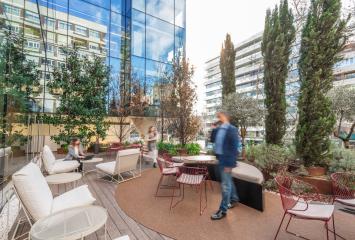Sustainability trends in 2023
Sustainability has become one of the main social concerns and consequently one of the key objectives of real estate activity. After all, building construction must always respond to individual and collective human needs. It is not an arbitrary exercise. And proof of this are the design and building actions aimed precisely at optimizing the resources used, reducing energy consumption, reducing greenhouse gas emissions and, in short, minimizing environmental impact, which are reaching the status of recurring solutions for construction companies. Many of them will be widespread trends by 2023. Let's take a look at the most relevant ones.
Glazing: windows to the world
Our direct experience with buildings such as the Marenostrum Tower or Wittywood has served to empirically certify the positive effects of large glass windows on many aspects of the daily lives of workers and managers. The openness to the outside world and the constant contact with natural light are points that have a very positive effect on individual well-being. However, the use of macro glazing also has a direct impact on the sustainability of buildings: sunlight reduces the consumption of artificial light and also of heating, since its radiation raises the temperature of the interior spaces. This is why it is an increasingly valued and used construction and design strategy.
Vegetation: CO2 absorption
The presence of plants in professional spaces has a calming effect that has an impact on cognitive performance. But there is another equally important reason for the incorporation of trees and other varieties of plants in the interior and exterior spaces of buildings: they are beings that capture the carbon dioxide present in the environment to, together with the available water and light, generate sugars for their own survival and oxygen that they expel back into the environment. In this sense, they are fundamental allies in the fight to reduce the human impact on the planet's climate. This, added to the aesthetic beauty they add to the environment, is leading to a flourishing of green spaces.
Local materials: reducing emissions
The last few years have served to confirm a very positive trend: the recovery of wood as a building material. From now on, and once we have assimilated all the benefits that its use provides compared to other common materials such as concrete or brick, especially in terms of sustainability, the question is not why use it, but where to get it. Ultimately, importing timber produced thousands of miles away eliminates much of its sustainability. Instead, the trend from 2023 onwards will be to use local woods, as well as hemp, plaster or local ceramic paint, all of which are quite environmentally friendly in the long term.
Open environments: optimizing space
The challenge is enormous: to meet the habitability and occupancy needs of an ever-growing humanity without having an excessively significant impact on natural habitats and the climate in general. And this requires, on many occasions, a wise use of available space. This is why open spaces with integrated and flexible solutions will soon become a key mechanism of real estate activity. Offices irreversibly compartmentalized into rooms, many of which are often underused, will give way to offices with very large, connected and versatile rooms. And modular furniture will have a lot to say in this respect.
Technological innovation: shortcut to efficiency
The right technologies can solve many of the sustainability needs of buildings. At Colonial, for example, we often use facility management technologies such as the Building Management System or renewable energy technologies that allow us to reduce or even eliminate natural gas consumption. And those are just two options among a myriad of alternatives. The reality is that technological development has always had an environmental impact, but also that this development, together with the will to take care of the planet, can lead to very effective solutions. And obviously the real estate sector is aware of this. Construction and design can no longer be understood without technical progress.

